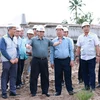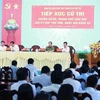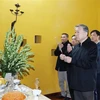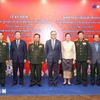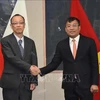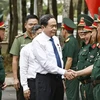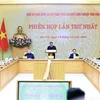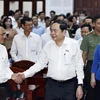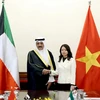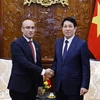Prime Minister Nguyen Tan Dung has requested infrastructure development mechanism and policy flaws be addressed to promote State management and prevent corruption and wastefulness in this field.
He made the remark while chairing a national teleconference in Hanoi on April 21 reviewing the implementation of Resolution No.13-NQ/TW on building synchronous infrastructure systems to turn Vietnam into a modern industrialised country by 2020. The resolution was issued by the Party Central Committee on January 16, 2012.
The Ministry of Planning and Investment (MPI) reported that the implementation of the resolution has reaped encouraging results and elevated infrastructure.
A number of transport projects were completed, improving domestic and international connections such as Ho Chi Minh City-Trung Luong and Noi Bai-Lao Cai Highways, Thang Long Boulevard, and Terminal T2 of Noi Bai International Airport. Other projects, especially those in key economic regions, are being accelerated.
While more investments were poured into energy projects, completed irrigation works helped foster agricultural activities, the ministry said, noting the expansion of information technology, education and healthcare facilities.
Infrastructure development has also been largely supported by business funding and people, it added.
At the conference, PM Nguyen Tan Dung said developing a synchronous infrastructure system is one of the strategic breakthroughs pivotal to the country’s rapid and sustainable growth. The outcomes over the past years have greatly contributed to socio-economic development, improved livelihoods and ensured security-defence.
He asked relevant ministries and localities to call for private funding, optimise the use of existing finances and ensure project quality. Meanwhile, localities must mitigate lingering problems in site clearance and compensation for land reclamation.
The leader also told the MPI to estimate infrastructure building expenses funded through the State budget, the Government bonds and official development assistance to inform a spending plan for the next five years.-VNA
He made the remark while chairing a national teleconference in Hanoi on April 21 reviewing the implementation of Resolution No.13-NQ/TW on building synchronous infrastructure systems to turn Vietnam into a modern industrialised country by 2020. The resolution was issued by the Party Central Committee on January 16, 2012.
The Ministry of Planning and Investment (MPI) reported that the implementation of the resolution has reaped encouraging results and elevated infrastructure.
A number of transport projects were completed, improving domestic and international connections such as Ho Chi Minh City-Trung Luong and Noi Bai-Lao Cai Highways, Thang Long Boulevard, and Terminal T2 of Noi Bai International Airport. Other projects, especially those in key economic regions, are being accelerated.
While more investments were poured into energy projects, completed irrigation works helped foster agricultural activities, the ministry said, noting the expansion of information technology, education and healthcare facilities.
Infrastructure development has also been largely supported by business funding and people, it added.
At the conference, PM Nguyen Tan Dung said developing a synchronous infrastructure system is one of the strategic breakthroughs pivotal to the country’s rapid and sustainable growth. The outcomes over the past years have greatly contributed to socio-economic development, improved livelihoods and ensured security-defence.
He asked relevant ministries and localities to call for private funding, optimise the use of existing finances and ensure project quality. Meanwhile, localities must mitigate lingering problems in site clearance and compensation for land reclamation.
The leader also told the MPI to estimate infrastructure building expenses funded through the State budget, the Government bonds and official development assistance to inform a spending plan for the next five years.-VNA
